

DOES THE VOCATIONAL SCHOOL APPROACH WORK?
A SUCCESSFUL MODEL - THE CAREER PATH PROGRAM
Joseph R. Zammit
Introduction
The purpose of this paper is to answer some key questions with regard to the focus and goals of a specific vocational program in a secondary school in Ontario . The results of the action research activity undertaken to respond to these questions certainly alleviated concerns regarding the future prospects of students enrolled in this type of vocational program. Data proved that, for this school, a “Career Path Program” is an excellent vocational method and that it prepares graduates for a work transition in a way and manner that best ensures the continuing success of each graduate. Based on the findings of this action research project, this Program should act as a model for taking students who are otherwise labeled as “at-risk” and successfully preparing them for direct transition into the workforce.
The original concerns and basis for this action research activity were synthesized down to five essential questions:
- Does the school and the “Career Path Program” currently meet its self-professed goal of providing an environment that is truly student based?
- Does the school and Program meet its goal of successfully and appropriately preparing these students for work placements?
- In the near and long-term future is there a credible job market for these students once they complete the Program?
- Are there any credible Apprenticeship/Post-Secondary opportunities for these students or will the Program limit their options in this area?
- What initiatives and strategies can be implemented to improve the Program?
The Career Path Program
The five essential questions where formulated after analyzing a specific vocational program called the “Career Path Program” in a large Ontario composite secondary school. At the time of the study the school had a total population of 1900 students of which 225 were enrolled in the Career Path Program. For the purposes of this study, the school shall be referred to as School X.
Each year the Program accepts 75 students at the grade nine level as well as a few in higher grades capping off the Program at 75 students per grade level. Students are bused to the Program from over 140 elementary and secondary schools in a large school district in Ontario.
All applicants are referred to the school through their Special Education Resource Teacher at their home school. Each application is reviewed by the Program Department Head and selected experienced Resource Teachers. All candidates are screened on the basis of the results of their psychological educational assessments. All grade 8 applicants that are accepted into the Program have a measured Grade Equivalence ranging from Grade 3 to Grade 6. The Review Committee attempts to determine if there are behavioral or other issues that would signal success or failure and appropriateness for the Program.
While other Vocational Programs in the Public School system grant Diplomas to their successful students, the Career Path Program at School X awards at the end of the four-year Program an Ontario Secondary School Certificate (OSSC). This is based on earning 14 credits or a Certificate of Accomplishment. Once a student enters the Program they are exempted from writing and passing the Ontario Secondary School Literacy Test (OSSLT).
It should also be noted that the OSSC and the completion of 14 credits includes credits awarded through co-op placement. The courses are geared toward the level of achievement of the students mirroring essential or locally developed courses.
In this Program a Grade nine student’s schedule looks like this:
Period 1 |
Period 2 |
Period 3 |
Period 4 |
40 minutes Math/ 40 Minutes GLE |
40 minutes 40 minutes English |
40 Minutes Lunch/ 75 Minutes Gym |
75 minutes Tech Courses i.e. Auto, Wood, Hospitality, Horticulture etc. |
Students in Grade 10 have similar scheduling while students in Grade 11 and Grade 12 have a semester in school and a Semester at a Co-op placement.
Here is an overall look at the Career Path Program:
Grade 9 |
Grade 10 |
Grade 11 |
Grade 12 |
Religion |
Religion |
Religion |
Religion |
English Literacy |
English Literacy |
English Literacy |
English Literacy |
Mathematics |
Mathematics |
Mathematics |
Mathematics |
Learning Strategies |
Career Studies |
Technology |
Technology |
Science |
Technology |
Cooperative Education |
Cooperative Education |
Physical Education |
Technology |
||
Integrated Technologies |
Elective |
The Goals of the Program
Firstly, the Career Path Program attempts to make the school environment a relaxed and comfortable learning environment. Classes are small, there is climate control in each room and students are provided with supplies and facilities that would best enable their success at school.
Secondly, the Program is not geared totally toward academic achievement but toward job or career placement. “It is our hope that students of the Career Path Program will have direct future employment…” (Career Path Program pamphlet)
The reality is that the great bulk of the Program accepts and trains the so-called “At-Risk” profile that under normal academic circumstances will:
- not have survived in a highly academic setting,
- would more than likely have dropped out of school by the time of the age of 16 or earlier and
- would experience great stress and difficulty in passing the OSSLT.
Answering the Five Essential Questions
1) Does the school and Career Path Program meet its self-professed goal of providing an environment that is truly student based?
Yes, it meets and exceeds this goal. The school and the Career Path Program are specifically focused on the true needs of its identified student population. An evaluation of the teaching and administration staff, and its leadership practices as well as the methodology of co-op contributes greatly to the determination that the Program is student-based:
a) Trained Staff
The Special Education Department of the School is currently staffed with 30 members, making this the largest department in the entire school. All members of the department have many years of experience teaching students with exceptionalities. Many were Special Education Resource Teachers from other elementary and secondary schools. Some are former Special Education Department Heads or Board consultants. These are all individuals who are experienced at not only instructing students with special needs but also developing curriculum. The school has assembled a virtual Special Education All-Star Team of teachers for this Program.As a result of this hiring practice, the design of the Career Path curriculum is based on sound pedagogical theory and practice. The Program does not focus on remedial efforts but instead on a direct school to work transition process. Therefore, students are taught the basics in each subject area that directly relate to what they will need to be successful at a job or work placement.
There are no classes over 15 students, and teachers are careful to make most work done in class with the teacher and EA assistance.
The experience of the team not only allows it to develop appropriate course material but also deal with the behaviors that other teachers may find challenging. There is a collaborative nature in the Department that helps to handle this aspect of teaching our Special Needs students. It should be also noted that currently there are 4.5 Educational Resource Workers or Educational Assistants in the Program
a) An Administration Team that is Sensitive to the Needs of the Students
Hand in hand with the teaching staff is the role of the administrative team. The Principal of the school initiated and ushered the Program into our school. He is acutely aware of the goals of our vocational program and very sensitive to the work that is involved in order to meet these goals. Above all he has recruited and hired the appropriate staff for this Program. He is also supported by three Vice-Principals who are also sensitive to the goals of the Program.b) Program Leadership that is Flexible to the Needs of the Students
On a daily basis the leadership of the school and Program meet with students and reviews with them their concerns or questions regarding aspects of the Career Path Program. Leadership is quick to react to approaches that have not worked. Specifically, Co-Op for students was discontinued when it was determined by both staff and students that they were being sent to workplace too early with the required skills for success. The teaching team is encouraged and welcomed to collaborative on issues as well as meet on a daily basis, mostly informally, to discuss concerns and problems with one another. The leadership of our department and our school has been completely accommodating and nurturing of this important dynamic.c) Co-Op Opportunities
The Career Path Program at School X currently houses 75 students in the Co-Op segment. The Program offers an excellent co-operative experience. There are over 130 possible employment placements. The Co-op experience allows that two semester placements for a total of 4 credits earned. There is great flexibility in the awarding of these credits. The rule of thumb is that a credit is equal to 110 hours of work, 2 credits are 220 hours etc.
2) Does the school currently meet its goal of successfully and appropriately preparing these students for work placements?
The answer here is also in the affirmative. The Career Path Program focuses on the training of students in five vocational areas. The Program offers courses in Horticulture, Auto, Wood, Hospitality and Hair and Aesthetics. Each curriculum has involved a tangible development and project on and off the school site.
The Career Path Horticultural classes have:
- Constructed and developed landscape features around the school
- Provided plantings for staff and students for holidays such as Christmas, mothers Day, Valentines Day etc.
- Provided plant centerpieces for the Dinner Theatre school play
- Provided plantings for the nearby Extended Health Care facility
- Developed a garden for the local Parish rectory and church
The Program has a large work space area with in excess of a 3000 square foot green house. The Auto shop is also a large and well stocked facility. There are three working bays with three-car hoists.
- The auto shop is in high demand and has a continual flow of cars, trucks and vans in repair
- Both staff and students utilize the services of this facility. (Note: on a personal level- I have had my own car repaired by students of the Program)
The Wood shop is another large and well equipped area. In the past year the Career Path students have:
- Made projects as gifts for holidays such as Christmas
- Constructed the set for the school play
- Constructed a large scale wood deck for the local Parish rectory
The Hospitality Program utilizes four separate rooms for food preparation. This includes the cafeteria serving counter and kitchen. During the year the Career Path in this segment of the Program has:
- Assisted in the preparation of food for all the students of the school lunch periods
- Served the food in the café serving counter
- Prepared food for special events such as staff meetings, breakfasts and team appreciation dinners
- Prepared and served food at the dinner theatre show
- Prepared and catered food for outside of school events for the board office and other private functions
The Hair and aesthetics programs have given students the opportunity to showcase their talents for:
- The school fashion show
- The school plays
- A hairdressing clinic offered to staff and students one –day a week
- Opened its doors to the community
- Assisted students in dressmaking and preparation for the school graduation
3) In the near and long-term future is there a credible job market for these students once they complete the Program?
| Currently, reviewing Figure 1 one can see some significance in job demand and the skills we are giving our students. Our vocational Program caters to Construction and the Service–Producing Sector which comprises of 79 % of the current job sector. |  |
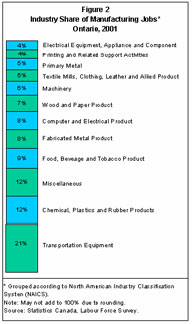 |
Figure 2 demonstrates the break down of Industry and Manufacturing job. Again, some of those positions are relevant for the jobs that our students may be able to get after leaving our Program. |
| But Figure 3 is perhaps more relevant in the areas of Transportation and Warehousing and Accommodation and Food. The Occupational grouping chart also validates certain sectors that will directly relate to our students. | 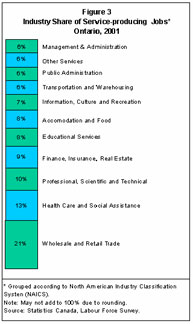 |
These figures and charts qualify that there is a demand for the jobs and skills that the Career Path Program is currently training students to be ready to transfer to after four years in the secondary level.
“Projections to the year 2007 indicate that the main source of new job creation will continue to be the service industries. Taken together, the transportation and communications; wholesale and retail trade; finance, insurance and real estate; community, business and personal services and public administration sectors will account for about three-quarters of the projected new jobs in the economy. The manufacturing and construction sectors are projected to contribute 19 and 4 percent respectively to new job creation. Primary resource industries will make a very modest contribution to projected job creation” (see Figure 6). ( Ontario Job Futures)

About 8 percent of new jobs are expected to be created among skilled trades. Found in construction, motive power, manufacturing and service sector industries (such as auto parts or hardware, tool and cutlery industries), skilled trades require a combination of education and on-the-job training and experience. In some trades, completion of an apprenticeship program is required. In other trades, apprenticeship training is available but not required for entry to the occupation. Examples of skilled trades are tool and die makers, crane operators, bricklayers, electricians, terrazzo floor layers, network cable specialists and automotive service mechanics (see Figure 7 - Ontario Job Futures).
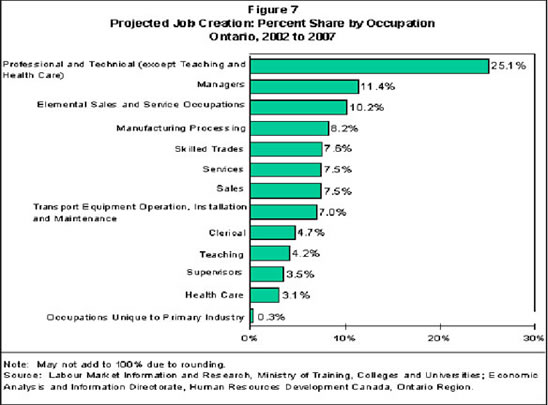
Replacement Needs
In addition to growth in an occupation, job opportunities are created when existing workers retire, leaving job vacancies that must be filled. The replacement needs created by the retirement of ageing workforces can lead to occupational shortages if trained or experienced workers cannot be found to take their place. As the baby boom cohort - which makes up one-third of Ontario 's population - enters its retirement years, an unusually large number of workers in senior management, teaching, some health disciplines, and skilled trades will be leaving the workforce (Ontario Job Futures).
Clearly, Figure 8 shows the industries in Ontario that will experience above average retirement rates to the year 2010. Figure 9 demonstrates the occupations that will experience above-average retirement rates. “Such replacement needs will open up job opportunities for new entrants to the workforce or for workers changing careers, which are reflected in the growth prospects identified for each occupation in Ontario Job Futures” (Ontario Job Futures).
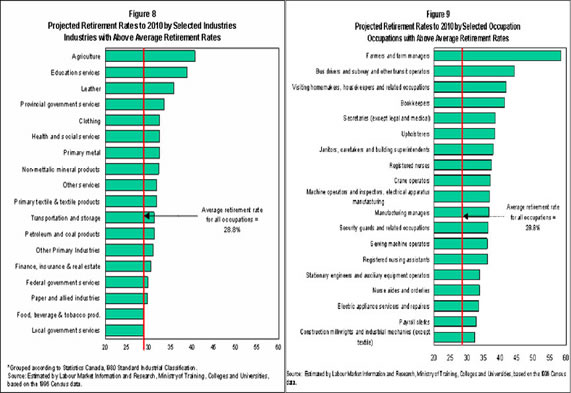
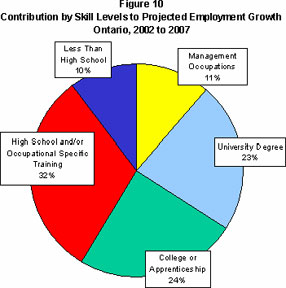 |
Statistically speaking, the philosophy and methods of the Career Path Program has a solid basis and foundation. There will be jobs for our graduates. In particular, our students are affected by the High School and/or Occupational Specific Training 32% segment which demonstrates as strong level of potential employment for the Career Path students (See Figure 10) |
4) Are there any credible Apprenticeship/Post-Secondary opportunities for these students or will the Program limit their options in this area
The higher paying service, trade and vocational services are positions that require some form of apprenticeship. The following sectors of trades will allow entrance without a Diploma:
Construction Sector
Boilermaker (10) |
Construction Craft Worker (10) |
Roofer (10) |
General Carpenter (10) |
Construction Millwright (10) |
Welder (10) |
Glazer/Metal Mechanic (10) |
Heavy Equipement Operator (12) |
Hoisting Engineer (12) |
Lather (Stucco) (10) |
Painting/Decorator (10) |
Plumber (10) |
Floor Covering Installer (12) |
Sheet Metal Worker (10) |
Electrician (12) |
Steam Fitter (10) |
Fire Protection Installer (10) |
(source: www.apprenticshipsearch.com)
Note - the number beside the profession indicates grade equivalency with no requirement of a “Diploma”. While a Diploma is preferable, the program will accept people with grade equivalency as the minimum of education acceptance.
Conversely, for the great amount of male students in our Program who are interested in auto-mechanics, the Apprenticeship programs available to the Motive Power Sector are limited:
Auto Electronics (12) |
Auto Power Parts (12) |
Truck and Coach Technician (12) |
Small Engine Technician (12) |
(source: www.apprenticshipsearch.com)
All other jobs in this field require a Diploma.
Service Sector:
Arborist (12) |
Assistant Cook (unrestricted) |
Baker (12) |
Cook (12) |
Early Childhood Educator (12) |
Educational Assistant (12) |
Hairstylist (12) |
Pastry Chef (12) |
Fruit Grower (12) |
(source: www.apprenticshipsearch.com)
The Economic Council of Canada has determined that the transition difficulty is a significant impediment to economic growth that needs to be rectified (Economic Council of Canada Report).
5) What initiatives and strategies can be implemented to improve the Program?
While the School X Career Path Program is an excellent vocational opportunity, there is always a need for improvement and potential. Specifically, there are three areas of concern:
- The College and Apprenticeship programs are very limited with information and assistance in this area still not fully active and available to the students. Recent efforts have been made to address this important aspect for our graduating students.
- The Program must never deviate from its focus of direct to work transition. In some cases the curriculum has become too theoretical. A more intrusive method of review might help to mitigate this issue.
- As the school and facilities grow older, there is a concern over funding requirements to keep equipment and technology up to date. Recent announcements from the Provincial government have been very favorable to vocational programs but political initiatives are always subject to change. Perhaps an alternate source of funding can be initiated through corporate sponsorship and endowments.
Conclusion
In the last few years the provincial government of Ontario has tracked a marked increase in the Secondary school drop-out rate. The elevated curriculum demands and the requirement to pass the OSSLT have been cited as contributors to that increase. In searching for the answers that will stem off the drop-out rate the government and boards of education across the province have turned to the vocational school methodology to best attract and retain at-risk students. If this is the chosen remedy, then educators and policy makers must be certain that vocational graduates will be able to obtain work placements. A process that determines methodology and type of vocational program is needed to determine as to how best to develop and run vocational programs in the province.
All stakeholders in vocational education must be assured that graduates will be able to get jobs relating to their school experience. In this action research paper, we have asked five essential questions determining the usefulness of a specific vocational method. The answers to these questions have indicated that Career Path approach at School X is an effective method of vocational program delivery. This program is effective and successful. Graduates will be able to find jobs and the skills that they are taught will be in demand in the future.
This action research study alleviates concerns regarding the future prospects of students enrolled in the program. The data proves fairly conclusively that the Career Path Program is an excellent form of vocational education and that it is preparing graduates for a work transition in a way and manner that will best ensure the continuing success of each graduate.
This program should act as a model for taking students who are otherwise labeled as “at-risk” and converting them into employable and contributing members of society. The Career Path Program will provide graduates with a direct and certain “path” to a future of employment.
Appendix: A
Survey results: Career Path Program Parental and Student Feedback: June 2003.
(The following is the survey results of enrolled students and their parents specifically regarding the Career Path Program at School X)
Positives of the Program Noted:
- students feel comfortable in the school environment
- Coop is an excellent practical aspect of the Program
- technology hands-on courses are most beneficial
- work experience is an effective tool
- Smaller classes are geared toward the academic level of the students
- more individual attention is provided
- work is not overwhelming -Program helped prepare students for the future
Negative Aspects and area that require changing:
- College options are very limited
- Wish that credit attainment was easier
- more technology courses should be provided
Biographical Note:
 Joseph R. Zammit is a Special Education Resource Teacher who works and resides in Mississauga , Ontario . Having been involved with Special Education since 1989 at the Secondary School level, he is currently placed in a composite secondary school where there is a direct school to work transition program. He has recently completed a Specialist in Special Education Studies. He can be reached at: JoeZammit66@hotmail.com
Joseph R. Zammit is a Special Education Resource Teacher who works and resides in Mississauga , Ontario . Having been involved with Special Education since 1989 at the Secondary School level, he is currently placed in a composite secondary school where there is a direct school to work transition program. He has recently completed a Specialist in Special Education Studies. He can be reached at: JoeZammit66@hotmail.com
